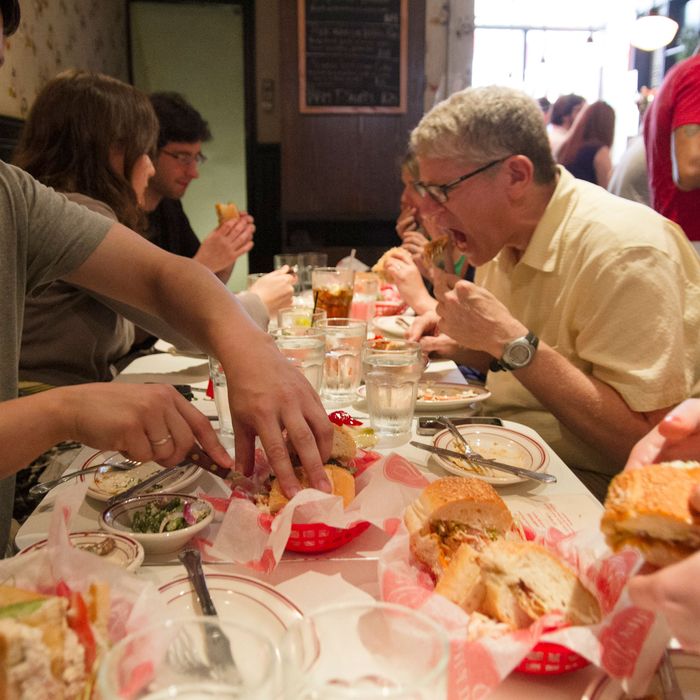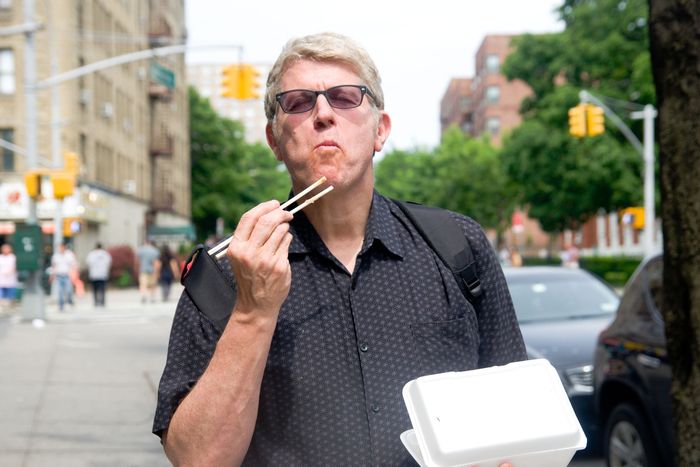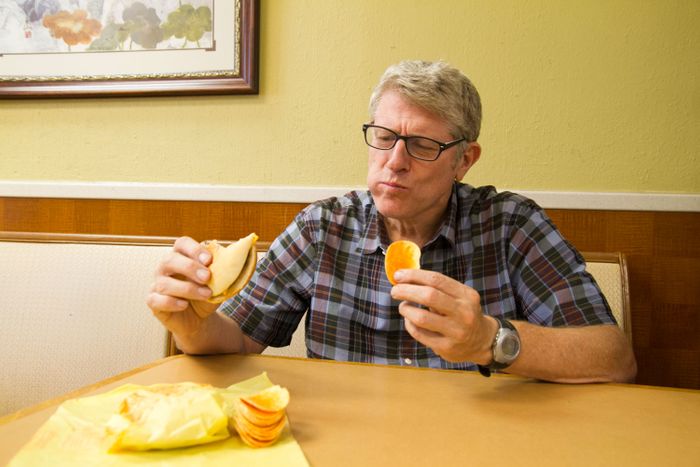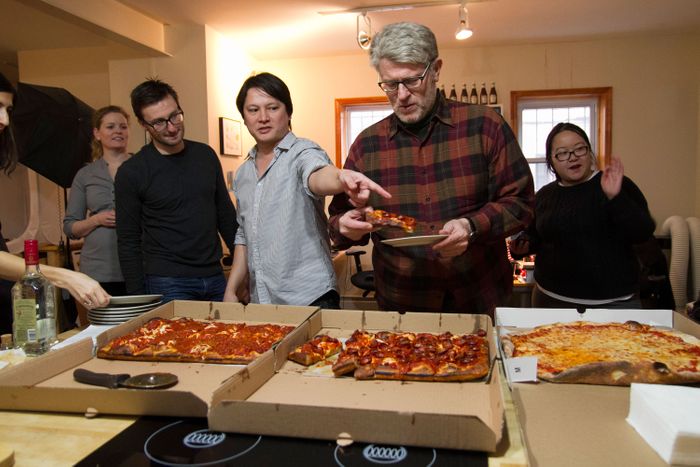
In 2006, when the biggest names on the internet still included MySpace and Geocities, a new site burst onto the scene that promised to be bookmarked by food nerds across cyberspace: Ed Levine — perhaps the ultimate food nerd — and his team of happy-go-lucky writers unleashed Serious Eats, and it was, in many ways, the “food blogger” trope made manifest. It didn’t take long before the site became a one-stop destination for the original deep-dive into In-n-Out’s secret menu; an exhaustive guide to Sri Lankan food on Staten Island; a column in which Levine grappled with dieting for 182 weeks; and 5,000 words on perfecting chocolate chip cookies. (I interned, for free, and then freelanced for the website, though I try not to think about how little I was paid.) Now, Levine has released a new memoir and, to celebrate the site’s dozen-plus (frequently cash-strapped) years in business, Grub Street talked to the culinary obsessives who toiled away in the site’s dumpling-strewn content mines during its earliest years.
I. The Big Idea
Ed Levine, founder: I had thought I was going to launch a competitor to the Food Network. The working title was Gusto. This was in 2004, 2005. I got a call from my friend. He was like, “Sorry, Comcast pulled out, and we don’t want to put out the money.” I’d been working for a year and a half on that thing! Then I talked to my old boss and he was like, “Screw them, just start a blog. Blogs are changing the face of media.” I just drank the kool-aid.
Pete Wells, New York Times restaurant critic: I did a promo video for Gusto. Honestly, all these years later and I’m still not sure what it was supposed to be called: “Gust-oh” or “Goose-toe.” I think Gabrielle Hamilton was there; Drew Nierporent was definitely there.
Levine: It was 2005, I had started Ed Levine Eats, which became Serious Eats. I was all-in on a blog, or a blogging network, becoming a business. The world was pregnant with possibility. The blogosphere was going to take over the world.
Adam Kuban, Serious Eats founding editor and Slice and A Hamburger Today founder: I was hired to help establish the voice of Serious Eats. He bought my sites in 2006 and brought me on, and the plan was originally that he was going to buy a bunch of smaller food blogs and create a larger blog with verticals under it. But then I think Meg Hourihan told him pretty early, “Don’t do that, because then you have to hire all the people.”
Meg Hourihan, Blogger co-founder and Serious Eats founding advisor: We came up with this plan where I could help him get it off the ground and provide expertise and experience where he didn’t have the right skills. Right off the bat, he wanted to make a new, web-based Food Network. He shared all these crazy numbers and I was like, “What are you talking about? You can afford to run your website for a month.”
Wells: Around the time Serious Eats launched, I joined the Times. The funny thing about the Times is, you realize you’re sort of in charge of things, and no one tells you. Around that time, Ed and I both started talking a lot about our separate struggles, you know, especially involving, ah, the internet! We were both like, “What does the internet want? What is it trying to tell us?” “What do we have to do to make it happy?” It turned out to be the wrong question.
Erin Zimmer Strenio, former editor and managing editor: I definitely thought Adam Kuban had it all figured out. I mean, Adam is such a talented editor. I still, in my head, feel like I have an Adam voice sometimes. He was a huge, huge part of the early days of Serious Eats.
Kuban: I didn’t know what I was doing. I just knew you had to put up content every day, but as far as the mix, I just kind of stumbled into it. Ed thought I knew more than I did, and I thought Ed knew more than he did.
Adam Roberts, Amateur Gourmet and Serious Eats blogger: I had just graduated NYU’s dramatic writing program and I was trying to support myself as a food blogger and a food writer. Ed came into my life sort of like a magical figure because he was like, “Hey, I love what you do and I want to pay you to do it on our site.” Ed felt like the P.T. Barnum of food people at the time, because he was gathering all these talents together.


II. The Money
Levine: We had an advertiser for our December, 2006 launch of Serious Eats with American Express. So it was like, “How hard can this be? We have a Fortune 500 company advertising with us.” And then I realized: They take a really long time to pay. Not 30 days, not 60 days, not 90 days, sometimes 180 days. And I had no recourse. What am I going to say? “I’m not going to accept your advertising money anymore”? That was the first time I said, “This is not going to be easy, Ed.”
Hourihan: In early 2007, we were trying to raise $1 million to try to fund everything for 18 months of operations. It’s not the kind of thing where people necessarily want to invest. We didn’t raise the $1 million.
Levine: No one wants to invest money to give you your dream job. And by the way, that’s what I really wanted, and what I was really asking. But if you put it that way, no one is going to give you the money. I just kept having to tell myself, “Okay we didn’t make those numbers and yeah I need more money.” Looking back it was crazy to keep going. It exacted a toll on my relationship with my brother and my marriage. But I just couldn’t consider stopping. In a way, if Serious Eats died, I felt like I would die.
Hourihan: I came from this entrepreneurial background where I had co-founded two companies. We started looking at the finances, and he had already gotten more money just from his brother, who was a primary investor, than I had ever gotten during our investment rounds when we started Blogger. He was paying himself what I thought was a huge salary, but I realized it was because he was an old entrepreneur. It’s not easy to start a company when you’re an established grownup. You have legitimate expenses. All of a sudden you need much more money out of your company. He needed to make money.
Levine: I was raising money in the beginning in $100,000 increments. If there was somebody I wanted to hire, I could only afford to do that if I raised more money. Otherwise revenues weren’t growing fast enough to be able to make new hires. By December, 2007 there was less than $50,000 in the Serious Eats bank account. That was exactly one month’s operating capital. The rule of thumb for startups is you’re always supposed to have a minimum of three months operating capital in the bank. So I was $100,000 short.
Hourihan: I think that financial pressure was there from the beginning, of just how to pay for this. It was all on Ed’s shoulders — he had real stuff to lose.
Levine: The second time I realized how hard it was going to be, was when I realized, “Wait, everyone says I’m the next new thing.” You know, the New York Times had called us the gastronomic super site or whatever. “The money is going to follow, Time says I have one of the 50 best websites on the internet!” That didn’t mean shit. It turns out you can’t take press clippings to the bank, or use them as collateral for a loan.
J. Kenji López-Alt, The Food Lab author and chief culinary consultant: There were internal struggles over doing direct sales, or specific product reviews, but I would point-blank tell Ed, “I’m not going to write this stuff. I’m not going to play with advertisers.” He’s running around trying to make it so we all get paid, and sometimes I’d write things that blatantly pissed off people who just spent money advertising with the site, and really put Ed in a tough position. For the first three or four years, I’m sure a lot of the financial headaches Ed had were caused by me and a couple other people, but I think Ed, to his credit, always came down on the side of, “You know what, you’re right” as soon as you pointed out the integrity argument. That’s all it took. This was something I believed in, and Ed believed in. It made me want to continue working there. He wasn’t going to sell out the editorial content just because he was in a desperate place, and there were a lot of desperate times.
III. Early Reaction
Marcus Samuelsson, chef and owner, Red Rooster: Serious Eats was very much just in, and of, the community. Ed ate with chefs, he was still a journalist, but it was all about the craftsman’s side. As a chef, you can’t help but adore that.
James Oseland, former Saveur editor-in-chief: When I got the job at Saveur, it was the same year he started Serious Eats. I was in awe early on with what was happening with the site. I saw its potential for storytelling and I was just so impressed with it. Serious Eats was an extension, the next chapter, in what Ed established with his book, you know?
Kuban: I would like to say that early on was a good mix of bloggy and professional. There was some very good stuff. You look at some of the stuff and the photography is terrible, the prose is crazy — it’s like travelogue ramblings. With a lot of the writers, I would chop a lot of that down, but I was hesitant to cut all of it because, at the time, they were working for peanuts.
Levine: There were all kinds of things we had to figure out. Especially in the early days, it allowed for unlimited experimentation. Because the cost of the experiment was very low, I didn’t mind that a lot of the experiments failed. A lot of our ideas didn’t work, but I loved that.
Wells: The thing that I think they had in the early days, that Ed had, was this willingness to go long, and to let people spend a while reporting these things. Ed had this sense that if they followed their passions, the readers would be there.
Levine: Because I had no money, and blogs weren’t paying any money, I was like, “I’m going to try to find the best young writers I can and give them freedom.”
Roberts: I mean, if you look at the columns that I wrote for Serious Eats they’re kind of crazy. They were just really out there and Ed always published them. He was a fan, which I really appreciated.
Dana Cowin, former Food & Wine editor-in-chief: I knew Ed as the totally obsessed, single-subject, deep-dive pizza guy. So here I was deep in the land of, like, chefs are everything and along comes a guy who was completely obsessed with single topics, like pizza. To me it was one of those zig-zag moments.
Carey Jones, former intern, founding editor of Serious Eats: New York, and former managing editor: The comment section was such a strong part of the site in its early days that we judged posts successful if they started conversations. Regional food was particularly big for this — writing about Primanti’s in Pittsburgh, Skyline Chili in Cincinnati and my own regional gem, Dutch Crunch bread in California. People really responded to things with emotional resonance for them, particularly in parts of the country that are written about less.
Wells: I remember really liking the restaurant coverage, because it seemed like it wasn’t driven by the industry and the scene and publicity — it was just what they felt was cool and good, and it had an anthropological streak. They would do things in kind of ridiculous steps, by the standards of the competition. It wasn’t even list-driven, like: Here are the ten Best Restaurants in St. Albans. It was: Here’s a community, and we want to explore it and help you understand it.
Samuelsson: It was to me, in its own way, almost Johnathan Gold-esque. It really piqued your curiosity, it got you to go places. It felt like it was new, and you didn’t know about it.
IV. Eating Everything
Jones: When Serious Eats was young and lean and had very little freelance budget, the editors took on all kinds of projects ourselves. My days could be spent in a Zipcar gathering bagels from deepest Queens, or driving to New Jersey because NYC supermarkets didn’t have a particular kind of frozen apple pie for a taste test, or cutting bagels — we went through a bagel phase — into “mobius bagels.”
Max Falkowitz, former Serious Eats and New York editor: The day-to-day often became night-to-night. It was a lot of working long hours and working weekends, and you never had a day off. It’s difficult to communicate to people how stressful it is to always be on, and to always worry about the next post.
Zimmer Strenio: The office was so small when I started in 2008, probably the size of a studio apartment. We had a narrow kitchen, more of a kitchenette really, with a fridge and toaster oven crammed in there. Nora Ephron came by for a frozen biscuit tasting — she loved biscuits — and the biscuits took forrrreverrrr to bake in our janky little toaster oven. She sent the first batch back because they weren’t golden brown enough. I was mortified. How could we serve sad biscuits to Nora Ephron?!
Maggie Hoffman, Serious Eats: Drinks founding editor and former managing editor: For staff, participating in taste tests was definitely not optional. I remember the store-bought eggnog one being pretty rough, and also one where we tasted every flavor of Spam.
Robyn Lee, former intern, editorial assistant, A Hamburger Today editor, and staff photographer and visual editor: To be honest, I’m not sure I can recall specific details about any of the food crawls because they’re just taking photos and face-stuffing, repeated over and over. Fun at first — until you realize you have eaten way too much and just want to eat the opposite of whatever you’ve just been eating all day.
López-Alt: There was a time we did a bagel taste test in NY and because bagels are only good for about half an hour after they’re baked, we had to time everything perfectly so that we got all bagels back to the office within a certain time window for a fair tasting.
Hoffman: JetBlue had this thing called the “All You Can Jet” passes. It was something crazy, like, for $600 you could take as many flights as you wanted, anywhere in the country.
Jones: Erin Zimmer, Robyn Lee, and I got the “All You Can Jet” passes, and we were on the road for 30 straight days. It was ludicrous. We’d fly to Seattle, hit up easily a dozen restaurants, and take a red-eye back. We’d fly into Pittsburgh for pierogis, drive up to Buffalo for wings and beef on weck, and fly back. Catch a 6:30 a.m. flight to New Orleans, try po’ boys and three beignet places and two sno-ball shops, plus a stop at Dooky Chase’s for gumbo … and be back at JFK by 7 p.m. We were, like, 24, so we had endless energy and the capacity to run on sleep from red-eye flights, but even at the time were a little awed by it. Like, “Is this really our job?”
Zimmer: That’s what “research” with Ed was like. He’s famous for saying, “The good ones learn to eat through the pain.”
Lee: My hours were like 10 to 7. After that, and on weekends, you’d go out to eat, which was technically more work, but I didn’t think of it that way. Work and personal life just mooshed together back then.
V. Recipes, Kenji, and the Cooking Lab
Kuban: I still remember when Ed was like, “We’re not going to be a recipe site because there are so many of those.” But, then, at one point, Ed was like, “I had lunch with Nick Denton and he told me, ‘If I had a food website I would do recipes for the search opportunities.’” So Ed was like, “We have to do recipes.”
Alaina Browne, general manager: Recipes aren’t easy to develop, but they’re evergreen in a way restaurant reviews aren’t. When you add in the techniques and affiliate links, you have a more compelling business proposition than a dining site, or what it was before, which was a hodgepodge of that.
Kuban: Our M.O. was, we’d have five recipes from one cookbook. It was the “Cook the Book” column. At first we weren’t cooking from them; they were people we knew and we assumed the recipes would work.
Levine: The “test kitchen” we had at the Grand Street office was an induction cooktop and an electric oven installed in a kitchen island. It cost $1,000 to $2,000 all together.
Kuban: After a while we finally hired someone to cook through the recipes, but it was still other people’s recipes. It wasn’t until Kenji came along that we started doing Food Lab-type stuff.
López-Alt: I was working at Cooks Illustrated and I wrote a story in 2007 about grinding your own beef for burger meat. When that was published, Adam Kuban blogged about it on A Hamburger Today. I saw that and it was the first time I’d seen Serious Eats. That’s how I initially got in touch with Adam. I wanted to try my hand at writing in my own voice. The first story I did was about making this burger recipe that Heston Blumenthal had in his book. Later, I decided to take a trip down to New York and eat at a bunch of burger joints between Connecticut and New York. So I emailed Adam and was like, “do you want me to write a story about that?” I think that was the second story I wrote. I did them both for Adam and basically just for fun. I guess Ed liked those stories and, pretty soon after, I got married and moved to New York.
Levine: When Kenji wrote a great piece for me, I was like, “This guy has a staggering amount of talent. Kenji, go crazy.” That was the assignment.
López-Alt: I was trying to find, specifically, an online outlet where I could write. Ed invited me out to lunch once and said to me, “You’re into food science right? You should write a food science book for home cooks.” I had never really thought about that. But when he said that it was like a light bulb. Like, Oh yeah, why am I not doing that? I should be doing that. It sounds really fun. So I did. A week later, I turned in the first Food Lab column. Erin Zimmer published it basically unedited except for typos.
Levine: Within three months, Kenji’s first Food Lab column got 144,000 page views, which was how we measured success at that time. That was 10 times what any recipe post on Serious Eats had gotten at that point.
López-Alt: There was a period of time where I was writing “Food Lab” articles freelance for $30 a piece, I was writing “a Sandwich a Day” articles for $10 a piece and $5 to $10 reimbursements. Then there was a several-month period where I was basically making nothing writing two to three articles a week just because I enjoyed it. My wife and I basically saw it as, if they’re paying me to develop these recipes, we can eat for a whole week — we’ll eat egg salad this week because I’m boiling hundreds of eggs for the column.
VI. Legacy
Falkowitz: The Serious Eats style of management is pretty much take smart, self-sufficient people who would rather work themselves to death than admit failure. The way that they figured it out not only dictated a lot of how they worked, but how the site grew. It was an office of young kids trying out this content, and we didn’t know anything. It was a period on the internet where you could still do that.
Cowin: It’s my sense that Serious Eats was admired as a beacon of something very particular. I think, over time, there were more people doing the type of thing Ed did. But, honestly, today, there are definitely people who come after, but I think they come from a different place.
Falkowitz: Look at what Bon Apétit is doing with its test kitchen staff, making them into individual personalities. Close to ten years ago now, we didn’t attract that level of fandom, but there weren’t only Kenji stans. There were also definitely Erin Zimmer stans, definitely Robyn Lee stans, there were some Max stans, LeAndra Palermo’s cereal column had a legion of fans.
López-Alt: I didn’t know it, but this is always what I wanted to do. If Ed hadn’t been there and suggested it, I wouldn’t have done it. I wouldn’t have figured that out. So, in that sense, I consider myself really lucky In many respects, but that’s one of the luckiest. If I hadn’t met Ed, I don’t know what I’d be doing now. Maybe I’d still be writing, maybe I’d have gone back to restaurants.
Hoffman: Because I was working so, so hard, it could feel like a thankless job. But people come up all the time — I was just on book tour, and people came up to me in every city — to say, “I learned to cook from Serious Eats.” That excitement about doing cooking in a scientifically supported way has either really found its audience, or shaped an audience of young cooks.
Levine: Early on, it was the greatest adrenaline rush I’d ever experienced. I just couldn’t believe I had created something that could hold that energy.








